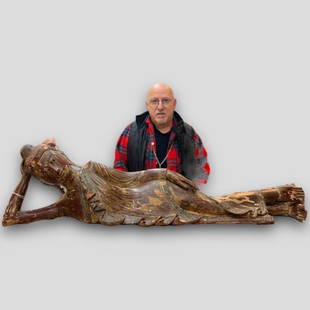
Altar of Reclining Buddha; Vietnam, Son La province, 18th century. Carved, lacquered and gilded
Similar Sale History
View More Items in ReclinersRelated Recliners
More Items in Recliners
View MoreRecommended Chairs
View More








Item Details
Description
Altar of Reclining Buddha; Vietnam, Son La province, 18th century.
Carved, lacquered and gilded wood, with carved and lacquered teakwood figure.
Presented on a modern oak table.
Measurements: 165 x 202 x 90 cm (temple); 40 x 131 x 40 cm (Buddha); 55 x 17 x 30 cm (lions).
An exceptional altar in the form of a temple, from the Vietnamese province of Son La, in the northern interior of the country, near the border with Laos. Dating from the 18th century, it is a small temple in richly carved wood, lacquered in gilt and black on a red background, which houses a solid teak sculpture of Buddha in round form, accompanied by two guardian lions, also carved in wood in round form and gilded in gilt.
Buddha is depicted in the posture known as Buddha Nirvana, which shows him lying down moments before he dies and transmigrates. This is a representation of the state in which Buddha leaves the earthly plane to attain Nirvana, a state in which he is liberated from suffering and the cycle of reincarnations, attaining Enlightenment, the supreme understanding.
Although Chinese influence in Vietnam has been of great importance since ancient times, the country cannot be considered merely a satellite of this mighty empire, but has a culture that is genuinely its own, as evidenced by examples of the importance of the imperial city of Hue. Indeed, much of Vietnamese culture and history has been shaped by the struggle for identity and survival of a people made up of fifty-four ethnic groups against the superiority of China and other nearby peoples at first, and later against Western colonialism. In fact, the imposition of Chinese influence on the country was forcefully reaffirmed as recently as 1802, when the Vietnamese emperor sent his ambassadors to Beijing to announce the union of the old kingdom of An Nam with that of the Viet Thuong under the new name of Nam Viet. However, the Chinese court did not approve of the new name, but only allowed the permutation of the two syllables, to avoid confusion with the old kingdom of Nam Viet Dong, of which some Chinese provinces were part.
The golden age of Vietnamese art was that of the Sham kingdoms (200-1720), although today it is a relatively little-studied civilisation. This is largely because the great achievements of Vietnamese culture are to be found not in the visual arts but in literature. Nevertheless, a brilliant art industry developed, albeit one deeply influenced by Chinese aesthetic, philosophical and religious ideas. However, some genuine artistic manifestations, such as water puppetry, were maintained, and Vietnamese phenomena such as Caodaism, a sect that originated in 1919, also emerged.
Carved, lacquered and gilded wood, with carved and lacquered teakwood figure.
Presented on a modern oak table.
Measurements: 165 x 202 x 90 cm (temple); 40 x 131 x 40 cm (Buddha); 55 x 17 x 30 cm (lions).
An exceptional altar in the form of a temple, from the Vietnamese province of Son La, in the northern interior of the country, near the border with Laos. Dating from the 18th century, it is a small temple in richly carved wood, lacquered in gilt and black on a red background, which houses a solid teak sculpture of Buddha in round form, accompanied by two guardian lions, also carved in wood in round form and gilded in gilt.
Buddha is depicted in the posture known as Buddha Nirvana, which shows him lying down moments before he dies and transmigrates. This is a representation of the state in which Buddha leaves the earthly plane to attain Nirvana, a state in which he is liberated from suffering and the cycle of reincarnations, attaining Enlightenment, the supreme understanding.
Although Chinese influence in Vietnam has been of great importance since ancient times, the country cannot be considered merely a satellite of this mighty empire, but has a culture that is genuinely its own, as evidenced by examples of the importance of the imperial city of Hue. Indeed, much of Vietnamese culture and history has been shaped by the struggle for identity and survival of a people made up of fifty-four ethnic groups against the superiority of China and other nearby peoples at first, and later against Western colonialism. In fact, the imposition of Chinese influence on the country was forcefully reaffirmed as recently as 1802, when the Vietnamese emperor sent his ambassadors to Beijing to announce the union of the old kingdom of An Nam with that of the Viet Thuong under the new name of Nam Viet. However, the Chinese court did not approve of the new name, but only allowed the permutation of the two syllables, to avoid confusion with the old kingdom of Nam Viet Dong, of which some Chinese provinces were part.
The golden age of Vietnamese art was that of the Sham kingdoms (200-1720), although today it is a relatively little-studied civilisation. This is largely because the great achievements of Vietnamese culture are to be found not in the visual arts but in literature. Nevertheless, a brilliant art industry developed, albeit one deeply influenced by Chinese aesthetic, philosophical and religious ideas. However, some genuine artistic manifestations, such as water puppetry, were maintained, and Vietnamese phenomena such as Caodaism, a sect that originated in 1919, also emerged.
Buyer's Premium
- 26%
Altar of Reclining Buddha; Vietnam, Son La province, 18th century. Carved, lacquered and gilded
Estimate €14,000 - €15,000
10 bidders are watching this item.
Shipping & Pickup Options
Item located in Barcelona, Barcelona, esOffers In-House Shipping
Payment

TOP























![Chinese Carved Hardstone Reclining Buddha: Chinese carved hardstone reclining Buddha, the sculpture modeled in content repose approaching Parinirvana, on a hardwood and marble stand. [4 3/4" H x 12 1/2" W x 3 1/4" D]. Light wear and abrasions.](https://p1.liveauctioneers.com/1221/271834/142407677_1_x.jpg?height=310&quality=70&version=1670618921)





















































